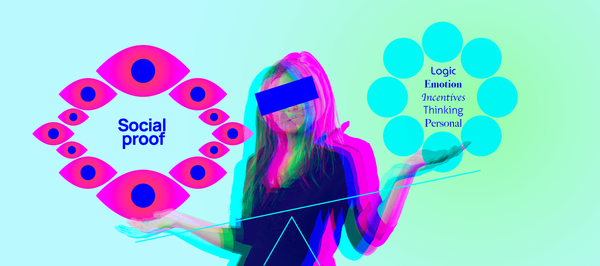How should we define “behavioral design,” and what does it look like in practice? What can make it a genuine game-changer in organizations, and what makes it challenging to execute?
We unpacked these questions in a conversation hosted by Scott Young on behalf of the Bescy Practitioners Group, bringing our own unique perspectives and examples to highlight key principles for practice. Although our backgrounds and experiences vary—Ruth brings years of applied practice to her academic role at the Institute of Design, a graduate-level design program; Asmina currently leads a behavioral strategy and insights team at McKinsey; and Ted brings deep user and behavioral research experience to cross-sector practice at BVA Nudge Consulting—several key themes emerged from the discussion about how to effectively move behavioral design from theory to real-world practice:
1. Start with the Behavior, Not the Feature
Before wireframes, campaign slogans, or policy drafts, good practice often begins by writing down the precise actions we want people to take (and avoid). This means drilling down until a target behavior can sit comfortably on a sticky note (“schedule a blood-pressure check,” “save 2% more,” “submit timesheets on time”) followed by exploring the context that shapes (and sometimes warps) those behaviors. Those clear behavioral targets then anchor every later conversation, whether with executives hungry for KPIs or with frontline staff who know where real friction lives.
2. Design as De-Risking
Even organizations that are genuinely enthusiastic about behavioral design’s potential value may be skeptical of new methods. Rather than positioning it as a silver bullet, emphasizing behavioral design as a way to “de-risk” solutions can be a compelling way to get folks on board. Presenting evidence from decades of research on what drives attention, motivation, or memory can turn taste-driven debates into informed risk assessments: “Here’s why the default wording reduces dropout” rather than “I just prefer this layout.”
3. Build Interdisciplinary Teams Early
Our most successful projects look less like traditional hierarchies and more like purposeful potlucks. Pair a service designer who sees journey pain-points with a behavioral scientist who spots cognitive traps; invite data analysts who can trace lagging indicators, along with copywriters who translate theoretical principles into everyday language.
The aim is to create generative tension, as each discipline catches what the others miss.
For leaders, that means budgeting for collaboration time, not just for individual deliverables.
4. Secure Stakeholder Allies—and Speak Their Dialect
Getting and maintaining support for including behavioral science in projects can be its own challenge, especially in organizations that may not fully understand why it’s useful. This is where building advocacy from above, often in the form of executive sponsors, can make the difference between being involved in the right way and being left out completely. It’s important to identify decision-makers with underlying questions (“We keep losing customers at this step… why?”) and equip these allies with a crisp business narrative—like cost-of-inaction, projected lift, or reputational upside—that helps them explain the value of a behavioral lens to their peers. When skeptics ask, “Why bring in a new methodology?” we need to answer in their language and currency: risk mitigated, revenue unlocked, compliance headaches spared.
5. Observe Real People, Not Just Metrics
There’s no substitute for observing humans in their natural habitat. A 10-minute screen-share of someone fumbling through a banking app provides insight into what people actually do, rather than what they say they do. Observation complements analytics, and while quantitative data reveals where drop-offs happen, seeing real-life activities can help uncover why things might not work as planned. Mixed-method research (like ethnography combined with A/B testing) can deliver a valuable combination of human insight and data-driven confidence.
6. Write a Behavioral Brief, Not a Slide Deck
Once insights crystallize, we hand partners a behavioral brief: a concise document that translates findings into design constraints, guiding principles, and testable hypotheses. It travels better than a slide deck because it speaks to multiple disciplines at once: product owners see backlog items; marketers see message hooks; engineers see acceptance criteria. Just as importantly, the behavioral brief notes unintended-use scenarios—“misuse modes” spotted while mapping behavior—to help teams preempt and avoid harm.
7. Measure What Matters
Being able to demonstrate that a proposed solution is likely to work is obviously an essential component of good professional practice. On one level, this means aligning on success metrics (like fewer payroll errors, higher on-time renewal, or lower call-center volume) and determining how they will be measured. But capturing qualitative indicators (like user quotes and stories), reflecting operational mental models, and using familiar language and values can also help build confidence in solutions and in the value of behavioral science.
8. Cultivate a Culture of Iteration and Humility
Behavioral science is a powerful lens and set of tools. But adhering too tightly to any one discipline can blind us to where other perspectives and approaches might be equally valuable. Getting the most from cross-disciplinary teams means cultivating openness to different perspectives and methods rather than sprinting ahead with our own familiar tools. When we see our work as both an opportunity to deliver successful outcomes for clients and as a learning opportunity to expand our own professional skills, we can help our teams achieve their goals more effectively, efficiently, and sustainably.
Closing Thoughts
Behavioral design is an everyday practice that aligns what organizations hope people will do with what people actually do. Marrying the rigor of behavioral science with the creativity of design—and grounding both in stakeholder realities—allows us to bridge the chasm between intent and impact. But it’s not a formula; there isn’t one single way to work best, and the diversity represented on this panel reflects the different ways in which applied behavioral science can be effective in practice.
This panel was hosted by the Bescy Practitioners Group, which hosts bimonthly sessions on varied topics of interest to the broader behavioral science practitioner community. For more information, contact Scott Young at scott.young@bescy.org






